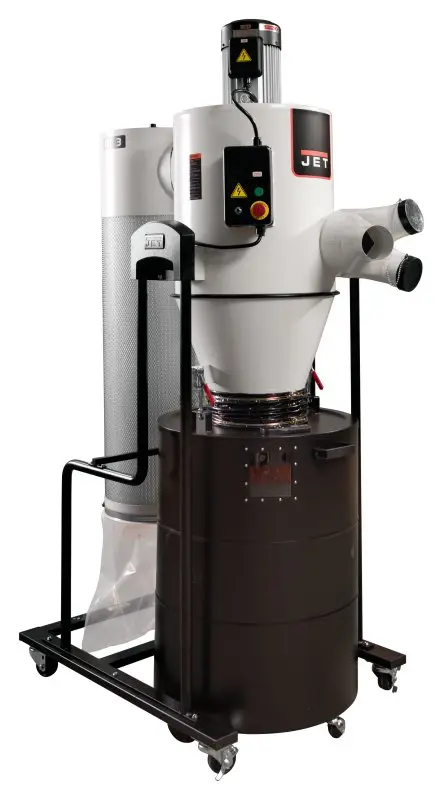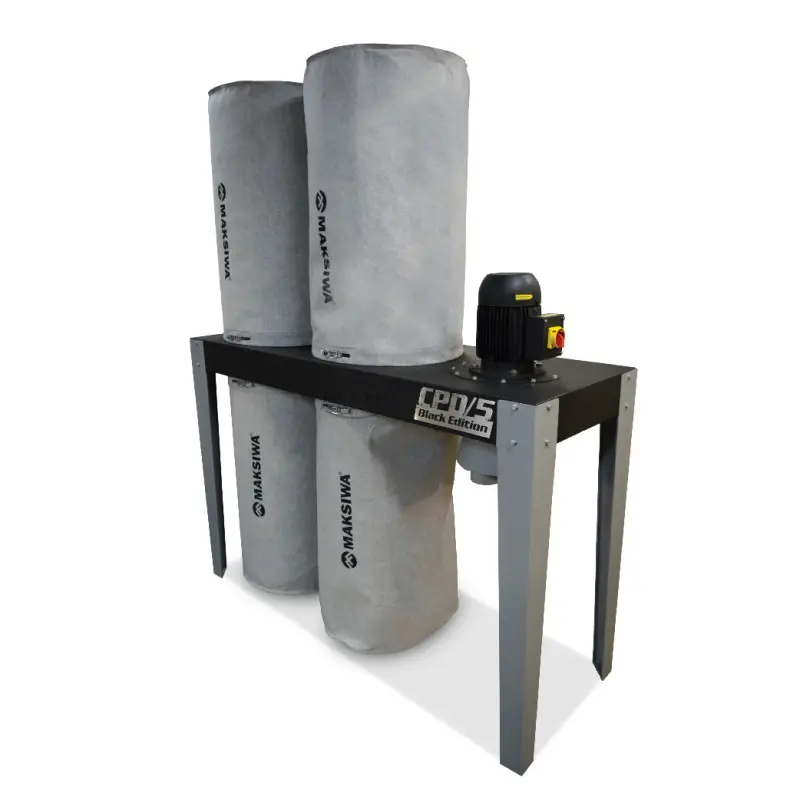Elite Metal Tools Articles
Industry news, tips, and updates on all things Elite Metal Tools
Let's Learn About - Dust Collection Basics
The Lets Learn About Series is an exercise in which we try to anticipate the most common questions as they relate to the purchase of machinery and accompany them with the answers. If you have a question that you think would be a good fit for this series please email insidesales@elitemetaltools.com.
A Comprehensive Guide to Dust Collectors: Enhancing Air Quality and Safety
The History of Dust Collectors: The history of dust collectors dates back to the industrial revolution when the need to control airborne particles became evident. Prior to the development of modern dust collection systems, workers in various industries faced significant health risks due to prolonged exposure to dust and contaminants.
- Early Developments: In the late 19th century, as industrialization surged, early attempts to control dust were made. Local exhaust ventilation systems and rudimentary dust collection devices, such as simple hoods and fans, were introduced to capture particles generated during manufacturing processes. However, these early systems had limited effectiveness and lacked proper filtration methods.
- The Emergence of Cyclone Collectors: In the early 20th century, the cyclone collector was invented, marking a significant advancement in dust collection technology. Cyclone collectors utilize centrifugal force to separate particles from the air stream, directing them into a collection bin while allowing clean air to be discharged. This innovation greatly improved dust separation efficiency and set the foundation for future developments in dust collection systems.
- Introduction of Baghouse Collectors: In the 1920s, the introduction of baghouse collectors revolutionized dust collection. Baghouse collectors utilize fabric filter bags to capture and retain dust particles. The dusty air is passed through the filter bags, allowing the particles to adhere to the fabric while clean air passes through. Baghouse collectors offered improved filtration efficiency and became widely adopted across various industries.
- Advancements in Cartridge Collectors: In the latter part of the 20th century, cartridge collectors emerged as an alternative to baghouse collectors. Cartridge collectors utilize pleated filter cartridges, which offer a larger surface area for filtration compared to traditional filter bags. This increased surface area allows for more efficient dust collection and easier maintenance, as the cartridges can be easily removed and replaced.
Technological Advancements: In recent years, advancements in technology have further enhanced the efficiency and performance of dust collectors. Intelligent control systems, smart sensors, and automated filter cleaning mechanisms have become more prevalent, allowing for real-time monitoring, energy optimization, and reduced maintenance requirements. Additionally, the development of high-efficiency filters, such as HEPA filters and nanofiber filters, has significantly improved filtration capabilities, ensuring cleaner air and safer working environments.
Dust Collection Basics:
- CFM Requirements per Machine: Effective dust collection starts with understanding the specific requirements of each machine. Different machines generate varying amounts of dust and debris during operation. Determining the required Cubic Feet per Minute (CFM) for each machine ensures that the dust collector's capacity matches the machine's needs. This optimization leads to efficient dust collection and improved air quality within the workspace.
- Blast Gates: Blast gates are crucial components in dust collection systems. These gates enable control over the airflow to individual machines, allowing for efficient dust capture at the source. By strategically positioning blast gates, operators can direct airflow precisely where it is needed, optimizing collection efficiency and minimizing energy consumption. When selecting and installing blast gates, factors such as size, material, and ease of use should be considered to ensure smooth operation and effective dust management.
- Flex Hose vs. Piped Systems: When designing a dust collection system, the choice between flexible hose and piped systems depends on various factors. Flex hose is highly versatile, allowing for easy maneuverability and adjustment, making it ideal for setups with machines that frequently change locations. On the other hand, piped systems offer a more permanent and rigid solution, ensuring consistent airflow and reducing the risk of leaks or clogs. The decision should consider factors such as the layout of the workspace, the distance between machines, and the nature of the materials being handled.
Benefits of Effective Dust Collection Systems: Implementing an efficient dust collection system offers numerous benefits to both businesses and employees. Let's explore some of the key advantages:
- Improved Air Quality: A robust dust collection system effectively removes harmful airborne particles, including dust, fumes, and other contaminants. By maintaining clean air in the workspace, employees enjoy a healthier working environment, minimizing the risk of respiratory issues and allergies./product/11904
- Reduced Health Risks: Exposure to airborne particles and contaminants can have long-term health consequences. Dust collectors help mitigate these risks by capturing and containing hazardous substances, protecting employees from potential health hazards.
- Compliance with Regulations: Many industries are subject to strict regulatory requirements regarding air quality and employee safety. Implementing an effective dust collection system ensures compliance with these regulations, avoiding potential fines and penalties.
- Enhanced Equipment Longevity: Dust particles can accumulate on machinery and equipment, leading to premature wear and breakdowns. By removing these particles from the air, dust collectors help maintain the performance and longevity of valuable equipment, reducing maintenance costs and downtime.
- Increased Productivity: A clean and healthy working environment promotes better focus, concentration, and overall productivity. By reducing distractions caused by airborne particles, dust collection systems contribute to improved efficiency and output.
Choosing the Right Dust Collector for Your Industry: Different industries require specific dust collectors to effectively address their unique needs. Here are some key factors to consider when selecting the appropriate dust collector for your industry:
- Particle Size: The size and type of particles generated by your processes will determine the filtration requirements of the dust collector. Fine particles may require more advanced filtration methods such as HEPA filters, while larger particles can be handled by standard filters.
- Airflow Requirements: Assess the airflow requirements of your machines and processes to ensure that the dust collector can handle the necessary volume. Consider factors such as the number of machines, their individual CFM requirements, and any anticipated future expansions.
- Filtration Efficiency: The efficiency of the dust collector's filtration system is crucial in capturing and retaining particles. Look for dust collectors with high-efficiency filters that can effectively remove contaminants from the air, promoting clean and safe working conditions.
- Maintenance Considerations: Evaluate the maintenance requirements of different dust collectors. Some systems may require frequent filter replacements or cleaning, while others offer longer filter life and easier maintenance. Consider the practicality and cost-effectiveness of maintenance tasks in your decision-making process.
- Noise Levels: Dust collectors can produce noise during operation, which may impact the working environment. If noise is a concern, look for models with noise reduction features or consider additional noise dampening measures to ensure a comfortable workplace.
Maintenance and Troubleshooting Tips for Dust Collectors: Proper maintenance is essential for maximizing the performance and lifespan of dust collectors. Here are some tips to keep your system running smoothly:
- Regular Filter Cleaning/Replacement: Dust collector filters can become clogged over time, diminishing their efficiency. Establish a regular maintenance schedule for cleaning or replacing filters to maintain optimal airflow and collection performance.
- Inspection of Motors and Fans: Periodically inspect the motors and fans of the dust collector for any signs of wear or damage. Lubricate bearings as necessary and ensure proper alignment to avoid unnecessary strain on the system.
- Check for Leaks: Inspect the ductwork and connections for any air leaks that can affect the efficiency of the dust collection system. Seal any gaps or cracks using appropriate sealing materials to maintain airtightness.
- Monitor Differential Pressure: Keep an eye on the differential pressure across the filters. A sudden increase in pressure may indicate clogged filters that need cleaning or replacement.
- Conduct Employee Training: Ensure that employees are educated on proper usage and maintenance practices for the dust collection system. Encourage them to report any issues or concerns promptly for timely resolution.
Innovations in Dust Collection Technology: The field of dust collection is continuously evolving, with advancements in technology enhancing efficiency and ease of use. Here are some notable innovations:
- Smart Sensors and Monitoring: Integrated sensors and monitoring systems provide real-time data on the performance of dust collectors. This enables proactive maintenance, identifies potential issues, and optimizes energy usage.
- Energy-Efficient Designs: Manufacturers are increasingly focusing on energy efficiency in dust collection systems. By incorporating energy-saving features such as variable frequency drives (VFDs) and intelligent control algorithms, these systems reduce power consumption without compromising performance.
- Automated Control Systems: Automated control systems enable precise control and monitoring of dust collection processes. They allow for customized settings, automatic filter cleaning, and remote access, enhancing system efficiency and ease of operation.
- Improved Filter Technologies: Advancements in filter technologies have led to increased filtration efficiency and extended filter life. HEPA filters, nanofiber filters, and self-cleaning filters are among the innovative options available, ensuring cleaner air and reduced maintenance requirements.
Spotlight on Maksiwa and Jet: Maksiwa and Jet are reputable brands in the dust collection industry, offering a range of products known for their quality and performance. Let's take a closer look at each brand:
- Maksiwa: Maksiwa is a trusted brand that specializes in woodworking machinery and equipment, including dust collectors. Their dust collection systems are designed to meet the needs of professional woodworkers and provide efficient and reliable performance. Maksiwa offers a variety of models with different capacities and filtration options, ensuring that you can find the right solution for your specific woodworking applications. With a commitment to quality and customer satisfaction, Maksiwa has earned a solid reputation in the industry./product/15499
- Jet: Jet is a well-established brand known for its wide range of woodworking and metalworking machinery, including dust collectors. Jet's dust collection systems are renowned for their durability, performance, and advanced features. They offer various models suitable for small workshops to large-scale industrial operations, ensuring efficient dust extraction and filtration. Jet's dust collectors often incorporate features like remote control operation, efficient filter cleaning mechanisms, and robust construction for long-term reliability.
Both Maksiwa and Jet prioritize the development of dust collection systems that meet industry standards, ensuring compliance with regulations and promoting a safe working environment. Their products undergo rigorous testing and are backed by reliable customer support, making them trusted choices for professionals in the woodworking and metalworking industries.
Today, dust collectors have become indispensable tools in industries such as woodworking, metalworking, construction, and manufacturing. They play a crucial role in maintaining air quality, protecting workers' health, and ensuring regulatory compliance. The continuous evolution of dust collection technology has led to more effective and efficient systems, contributing to safer and more productive work environments.
Conclusion: The history of dust collectors showcases the progression from basic ventilation systems to sophisticated filtration technologies. From the early days of local exhaust ventilation to the emergence of cyclone collectors, baghouse collectors, and cartridge collectors, each development has brought us closer to achieving cleaner and safer workspaces. With ongoing advancements and innovations, dust collectors continue to evolve, offering higher efficiency, better filtration, and improved control mechanisms. Understanding the history of dust collectors helps us appreciate the importance of these systems in modern industries and highlights the continual efforts to enhance workplace safety and air quality.

